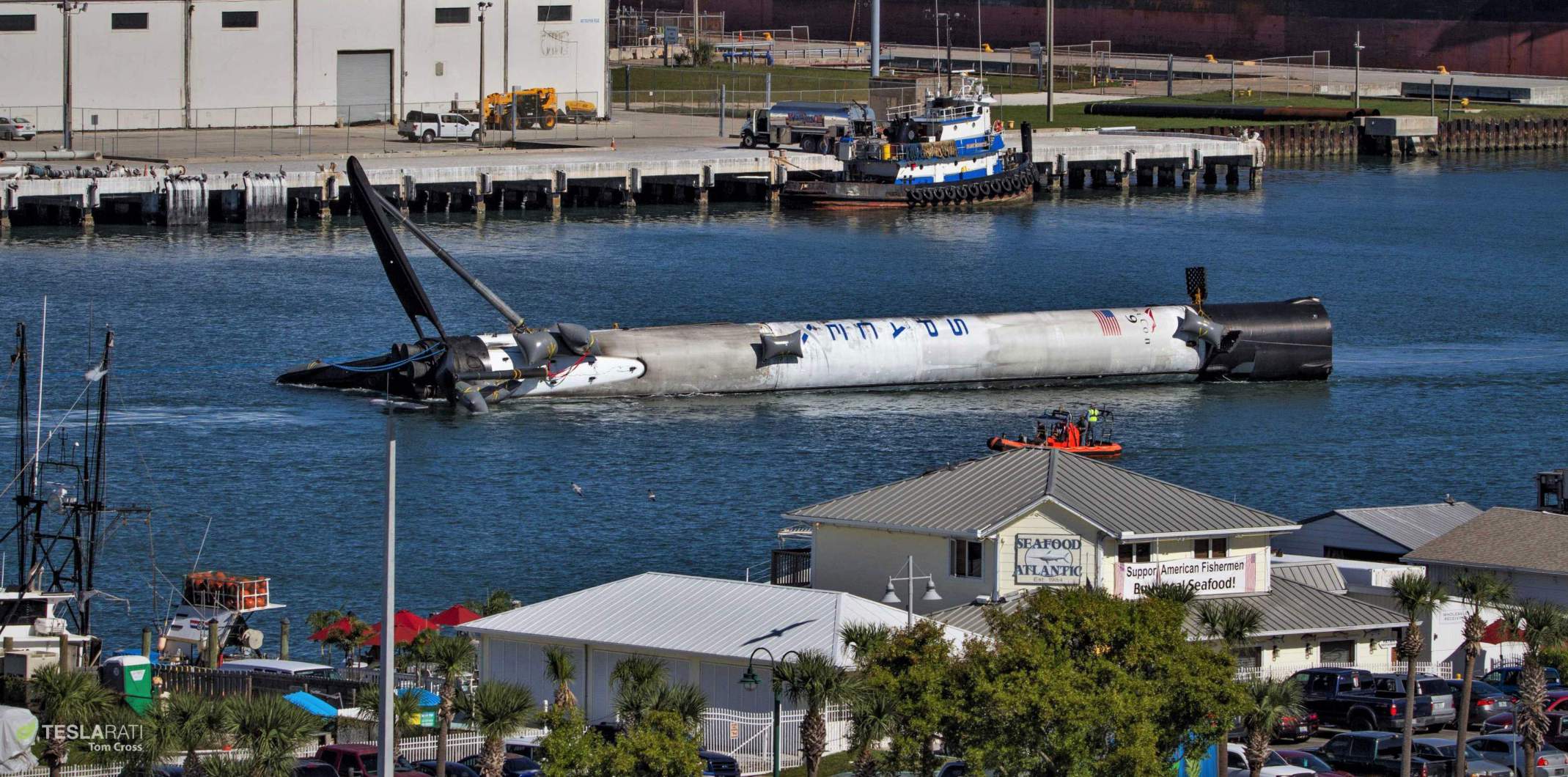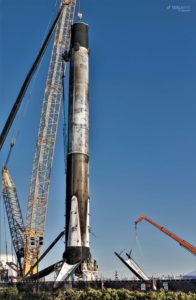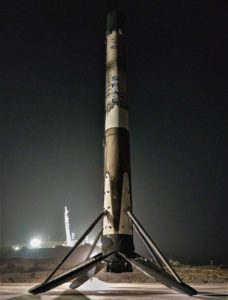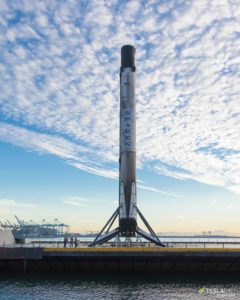

News
SpaceX’s partial Falcon 9 landing failure could delay next West Coast launch
According to statements made by the Canadian Space Agency (CSA) and media outlet CBC, the launch of the agency’s next-generation Radarsat Constellation Mission (RCM) – a trio of Earth observation satellites weighing >4200 kg (9300 lbs) – has been “postponed … indefinitely” as a consequence of SpaceX’s first failed Falcon 9 booster landing since 2016.
Offering a rare glimpse into some of the extensive planning that goes on behind the scenes to make commercial rocket launches happen, CSA has indicated that the booster it planned to launch on – Falcon 9 B1050 – suffered an untimely (partial) demise during a recovery attempt shortly after successfully launching the CRS-16 Cargo Dragon mission on December 5th, 2018. While the booster shockingly was returned to dry land mostly intact after landing in the Atlantic, SpaceX and CSA must now settle on a different Falcon 9 to launch the mission.
A problem with a SpaceX booster rocket has postponed the launch of a $1 billion Canadian satellite program indefinitely. https://t.co/45qirdId5j @DeanBeeby
— CBC News (@CBCNews) January 15, 2019
Goldilocks and the Falcon boosters
While it doesn’t look like there are only three possible rocket options for the Radarsat constellation and SpaceX to choose from, the situation of picking a new booster this late in the launch flow is far less simple than it might initially seem. First and foremost, SpaceX likely needs to do its best to accommodate the preferences of customers CSA and MDA (MacDonald, Dettwiler and Associates Ltd.) regardless of how disruptive they may be. Originally targeted for sometime in November 2018, RCM’s launch slipped several months to the second half of February 2019 due to what CSA described as “higher priority missions [for]the US Government and a backlog of launches from…Vandenberg” late last year.
While that alone does not point directly towards any obvious explanations, CBC reporter Dean Beeby’s implication that the mission’s launch is now “postponed…indefinitely” offers a hint of an answer, although it could also be manufactured hyperbole where there actually is none. If CSA actually indicated that the launch is now postponed indefinitely, the only clear explanation for a launch delay greater than a month or so as a result of Falcon 9 B1050’s unplanned unavailability would lie in some unique aspect of that particular Falcon 9 booster.
Although each rocket SpaceX builds can be quite different from each other in terms of general quirks and bugs, the only obvious difference between B1050 and any other flight-proven Falcon 9 booster in SpaceX’s fleet was its low-energy CRS-16 trajectory, something that would have enabled a uniquely gentle reentry and landing shortly after launch. In other words, likely out of heaps of caution and conservatism if it is the case, customers CSA and MDA may have requested (or contractually demanded) that SpaceX launch the Radarsat constellation on a flight-proven Falcon 9 with as little wear and tear as possible, in which case B1050 would have been hard to beat.
“Unfortunately, the landing of [Falcon 9 B1050] was unsuccessful, preventing SpaceX from recuperating the reusable components for the launch of RCM. We continue to work closely with MDA and SpaceX to confirm a launch date for RCM.” – Spokesperson Audrey Barbier, Canadian Space Agency (CSA), 01/15/2019
If the customers remained steadfast in their (speculated) request for a gently-used flight-proven Falcon 9 even after B1050’s partial landing failure, the next most comparable booster would be Falcon 9 B1051 after launching the first orbital Crew Dragon mission sometime no earlier than (NET) February 2019. Aside from B1051, there will be no obvious booster alternative available for at least several months after Crew Dragon’s launch debut, unless NASA requests that its next contracted Cargo Dragon mission (CRS-17) launch on a new Falcon 9 rocket in March 2019.
Engines stabilized rocket spin just in time, enabling an intact landing in water! Ships en route to rescue Falcon. pic.twitter.com/O3h8eCgGJ7
— Elon Musk (@elonmusk) December 5, 2018
Warmer…
If a less lightly-used booster becomes an option for CSA/MDA, there are immediately multiple clear options available as long as SpaceX is will to accept possible delays to subsequent launches to quickly reassign a flight-proven Falcon 9. Falcon 9 B1046 – the first SpaceX rocket ever to launch three orbital-class missions – is being refurbished at SpaceX’s Hawthorne, California facilities a few hundred miles south of Vandenberg. B1047 completed its second successful launch in November 2018 and is being refurbished – along with the twice-flown B1048 – in Cape Canaveral, Florida. Finally, Falcon 9 B1049 completed its second successful launch just days ago (January 11th) and is being processed off of drone ship Just Read The Instructions (JRTI) at this very moment.
B1047 or B1048 have likely been assigned to the imminent NET February 18th launch of Indonesian commsat PSN-6 and SpaceIL’s Beresheet Moon lander, meaning that the best possible option for Radarsat – short of swallowing months of additional delays – is a decision between B1047/B1048 or B1046, with B1049 also a candidate if a slip into March or April is an option. Still, all of those options would require Canada and MDA to fly on a Falcon 9’s third (or fourth) launch, perhaps an unacceptable compromise or perceived risk for certain customers.
- Falcon 9 B1046 is processed in Port of LA shortly after its third successful launch and landing, December 2018. (Pauline Acalin)
- Falcon 9 B1047 is pictured here beneath an upper stage and satellite Es’hail-2 prior to its second launch. (Tom Cross)
- Falcon 9 B1048 landed at LZ-4 after its second launch and is now being refurbished on the opposite coast. (SpaceX)
Meanwhile, schedule pressures have meant that SpaceX is pushing as hard as possible to prepare three new Block 5 Falcon Heavy boosters for the giant rocket’s second and third launches, scheduled as early as March and April 2019. While unconfirmed, it appears that SpaceX may have chosen to manufacture all three of those boosters one after the other, meaning that the company’s Hawthorne factory would have been primarily focused on delivering those rockets for at least 2-3 months start to finish. In short, it does not appear that there is or will be an unflown Falcon 9 booster available for Radarsat anytime soon.
Whether the customers wait for a new booster to be produced, wait for Crew Dragon’s first launch to wrap up, or accept being the third or fourth launch of a well-scorched Falcon 9, RCM’s next published launch target should offer a hint as to how CSA, MDA, and SpaceX ultimately decided to respond to Falcon 9 B1050’s dip in the Atlantic OCean.
Elon Musk
Tesla Supercharger Diner food menu gets a sneak peek as construction closes out
What are you ordering at the Tesla Diner?

The Tesla Supercharger Diner in Los Angeles is nearing completion as construction appears to be winding down significantly. However, the more minor details, such as what the company will serve at its 50s-style diner for food, are starting to be revealed.
Tesla’s Supercharger Diner is set to open soon, seven years after CEO Elon Musk first drafted the idea in a post on X in 2018. Musk has largely come through on most of what he envisioned for the project: the diner, the massive movie screens, and the intended vibe are all present, thanks to the aerial and ground footage shared on social media.
We already know the Diner will be open 24/7, based on decals placed on the front door of the restaurant that were shared earlier this week. We assume that Tesla Optimus will come into play for these long and uninterrupted hours.
The Tesla Diner is basically finished—here’s what it looks like
As far as the food, Tesla does have an email also printed on the front door of the Diner, but we did not receive any response back (yet) about what cuisine it will be offering. We figured it would be nothing fancy and it would be typical diner staples: burgers, fries, wings, milkshakes, etc.
According to pictures taken by @Tesla_lighting_, which were shared by Not a Tesla App, the food will be just that: quick and affordable meals that diners do well. It’s nothing crazy, just typical staples you’d find at any diner, just with a Tesla twist:
Tesla Diner food:
• Burgers
• Fries
• Chicken Wings
• Hot Dogs
• Hand-spun milkshakes
• And more https://t.co/kzFf20YZQq pic.twitter.com/aRv02TzouY— Sawyer Merritt (@SawyerMerritt) July 17, 2025
As the food menu is finalized, we will be sure to share any details Tesla provides, including a full list of what will be served and its prices.
Additionally, the entire property appears to be nearing its final construction stages, and it seems it may even be nearing completion. The movie screens are already up and showing videos of things like SpaceX launches.
There are many cars already using the Superchargers at the restaurant, and employees inside the facility look to be putting the finishing touches on the interior.
🚨 Boots on the ground at the Tesla Diner:
— TESLARATI (@Teslarati) July 17, 2025
It’s almost reminiscent of a Tesla version of a Buc-ee’s, a southern staple convenience store that offers much more than a traditional gas station. Of course, Tesla’s version is futuristic and more catered to the company’s image, but the idea is the same.
It’s a one-stop shop for anything you’d need to recharge as a Tesla owner. Los Angeles building permits have not yet revealed the date for the restaurant’s initial operation, but Tesla may have its eye on a target date that will likely be announced during next week’s Earnings Call.
News
Tesla’s longer Model Y did not scale back requests for this vehicle type from fans
Tesla fans are happy with the new Model Y, but they’re still vocal about the need for something else.

Tesla launched a slightly longer version of the Model Y all-electric crossover in China, and with it being extremely likely that the vehicle will make its way to other markets, including the United States, fans are still looking for something more.
The new Model Y L in China boasts a slightly larger wheelbase than its original version, giving slightly more interior room with a sixth seat, thanks to a third row.
Tesla exec hints at useful and potentially killer Model Y L feature
Tesla has said throughout the past year that it would focus on developing its affordable, compact models, which were set to begin production in the first half of the year. The company has not indicated whether it met that timeline or not, but many are hoping to see unveilings of those designs potentially during the Q3 earnings call.
However, the modifications to the Model Y, which have not yet been officially announced for any markets outside of China, still don’t seem to be what owners and fans are looking forward to. Instead, they are hoping for something larger.
A few months ago, I reported on the overall consensus within the Tesla community that the company needs a full-size SUV, minivan, or even a cargo van that would be ideal for camping or business use.
Tesla is missing one type of vehicle in its lineup and fans want it fast
That mentality still seems very present amongst fans and owners, who state that a full-size SUV with enough seating for a larger family, more capability in terms of cargo space for camping or business operation, and something to compete with gas cars like the Chevrolet Tahoe, Ford Expedition, or electric ones like the Volkswagen ID.BUZZ.
We asked the question on X, and Tesla fans were nearly unanimously in support of a larger SUV or minivan-type vehicle for the company’s lineup:
🚨 More and more people are *still* saying that, despite this new, longer Model Y, Tesla still needs a true three-row SUV
Do you agree? https://t.co/QmbRDcCE08 pic.twitter.com/p6m5zB4sDZ
— TESLARATI (@Teslarati) July 16, 2025
Here’s what some of the respondents said:
100% agree, we need a larger vehicle.
Our model Y is quickly getting too small for our family of 5 as the kids grow. A slightly longer Y with an extra seat is nice but it’s not enough if you’re looking to take it on road trips/vacations/ kids sports gear etc.
Unfortunately we…
— Anthony Hunter (@_LiarsDice_) July 17, 2025
Had to buy a Kia Carnival Hybrid because Tesla doesn’t have a true 3 row vehicle with proper space and respectable range. pic.twitter.com/pzwFyHU8Gi
— Neil, like the astronaut (@Neileeyo) July 17, 2025
Agreed! I’m not sure who created this but I liked it enough to save it. pic.twitter.com/Sof5nMehjS
— 🦉Wise Words of Wisdom – Inspirational Quotes (IQ) (@WiseWordsIQ) July 16, 2025
Tesla is certainly aware that many of its owners would like the company to develop something larger that competes with the large SUVs on the market.
However, it has not stated that anything like that is in the current plans for future vehicles, as it has made a concerted effort to develop Robotaxi alongside the affordable, compact models that it claims are in development.
It has already unveiled the Robovan, a people-mover that can seat up to 20 passengers in a lounge-like interior.
The Robovan will be completely driverless, so it’s unlikely we will see it before the release of a fully autonomous Full Self-Driving suite from Tesla.
Energy
Tesla launches first Virtual Power Plant in UK – get paid to use solar
Tesla has launched its first-ever Virtual Power Plant program in the United Kingdom.

Tesla has launched its first-ever Virtual Power Plant program in the United Kingdom. This feature enables users of solar panels and energy storage systems to sell their excess energy back to the grid.
Tesla is utilizing Octopus Energy, a British renewable energy company that operates in multiple markets, including the UK, France, Germany, Italy, Spain, Australia, Japan, New Zealand, and the United States, as the provider for the VPP launch in the region.
The company states that those who enroll in the program can earn up to £300 per month.
Tesla has operated several VPP programs worldwide, most notably in California, Texas, Connecticut, and the U.S. territory of Puerto Rico. This is not the first time Tesla has operated a VPP outside the United States, as there are programs in Australia, Japan, and New Zealand.
This is its first in the UK:
Our first VPP in the UK
You can get paid to share your energy – store excess energy in your Powerwall & sell it back to the grid
You’re making £££ and the community is powered by clean energy
Win-win pic.twitter.com/evhMtJpgy1
— Tesla UK (@tesla_uk) July 17, 2025
Tesla is not the only company that is working with Octopus Energy in the UK for the VPP, as it joins SolarEdge, GivEnergy, and Enphase as other companies that utilize the Octopus platform for their project operations.
It has been six years since Tesla launched its first VPP, as it started its first in Australia back in 2019. In 2024, Tesla paid out over $10 million to those participating in the program.
Participating in the VPP program that Tesla offers not only provides enrolled individuals with the opportunity to earn money, but it also contributes to grid stabilization by supporting local energy grids.
-

 Elon Musk1 day ago
Elon Musk1 day agoWaymo responds to Tesla’s Robotaxi expansion in Austin with bold statement
-

 News1 day ago
News1 day agoTesla exec hints at useful and potentially killer Model Y L feature
-

 Elon Musk2 days ago
Elon Musk2 days agoElon Musk reveals SpaceX’s target for Starship’s 10th launch
-

 Elon Musk3 days ago
Elon Musk3 days agoTesla ups Robotaxi fare price to another comical figure with service area expansion
-

 News1 day ago
News1 day agoTesla’s longer Model Y did not scale back requests for this vehicle type from fans
-

 News1 day ago
News1 day ago“Worthy of respect:” Six-seat Model Y L acknowledged by Tesla China’s biggest rivals
-

 News2 days ago
News2 days agoFirst glimpse of Tesla Model Y with six seats and extended wheelbase
-

 Elon Musk2 days ago
Elon Musk2 days agoElon Musk confirms Tesla is already rolling out a new feature for in-car Grok




















